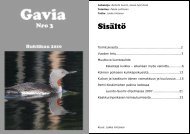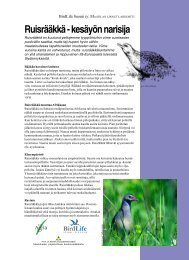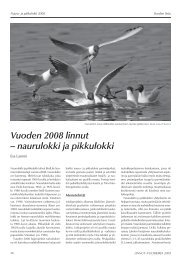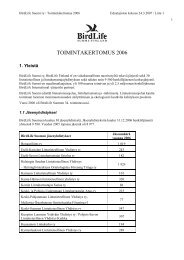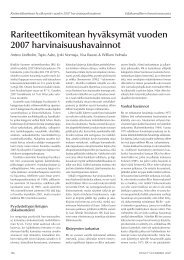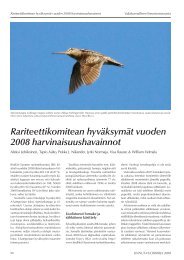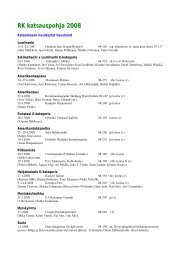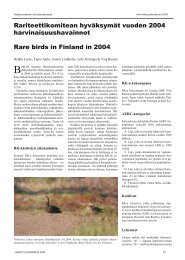Metsiensuojelun tavoitteita 2000-luvun suomessa - BirdLife Suomi
Metsiensuojelun tavoitteita 2000-luvun suomessa - BirdLife Suomi
Metsiensuojelun tavoitteita 2000-luvun suomessa - BirdLife Suomi
- No tags were found...
Create successful ePaper yourself
Turn your PDF publications into a flip-book with our unique Google optimized e-Paper software.
Changes in legislationBy 2020, forest key habitats (sites of 10 hectares or less), their buffer zones, as well as habitatsof endangered species should total around three per cent of commercial forests. Thisrequires changes in Article 10 of the Finnish Forest Act. Article 10 also does not recogniseall the important Finnish forest key habitat types, which in practice must be listed in theForest Act to qualify for protection and landowner compensation. The Forest Act shouldalso require protection of all species listed as nationally or regionally endangered in Finland,rather than use a separate list of species defined as requiring special protection. Article 6 ofthe Forest Act (on logging in sensitive areas) requires a clear interpretative set of instructionsfor application at the national level. The Act on Containing Insect and Fungal Pests (263/91)and its application instructions should take account of biodiversity viewpoints, includingrecent scientific results on the true risks posed by pest species.Improving Landscape Ecological PlanningLandscape Ecological Planning (LEP) should be extended from state forests particularlyto larger forests owned by industry and other large corporations such as churches and municipalities.In state forests a second round of LEP is urgently needed to correct the errorsstill prevalent after the first round of planning.Conservation management in commercial forestsThe greatest conservation problem in Finnish commercial forests is the excessively small sizeand insufficient number of its protected elements, such as the forest key habitats recognisedby the Finnish Forest Act. The amount of dead and rotting wood in commercial forests mustalso be increased significantly, as lack of such wood is the single most important reason forthe poor showing of many endangered and demanding species. Commercial forest managementshould be developed towards greater imitation of natural processes away from thecurrent practice favouring even-aged stands of a single tree species.Government subsidies to the forest sector harmful to biodiversityIn Sweden, commercial aspects of forest management such as forestry road building nolonger receive state subsidies since the mid-1990s. Money so saved was channelled intoenvironmental management and protection of forest key habitats. Finland should followsuit.Diversifying forest management advisory servicesCurrent forest management advisory services place excessive emphasis on economic aspects.Such services should be developed to help protect biodiversity and to assist such forestowners as wish to emphasise the natural values or pluralistic use of their land. The environmentaladministration should become involved with the forest management advisoryprocess. The monopoly on advisory services currently granted by law to Regional ForestrySocieties should be withdrawn; this would open the way to societies and organisations offeringmore varied approaches to forest management.69



